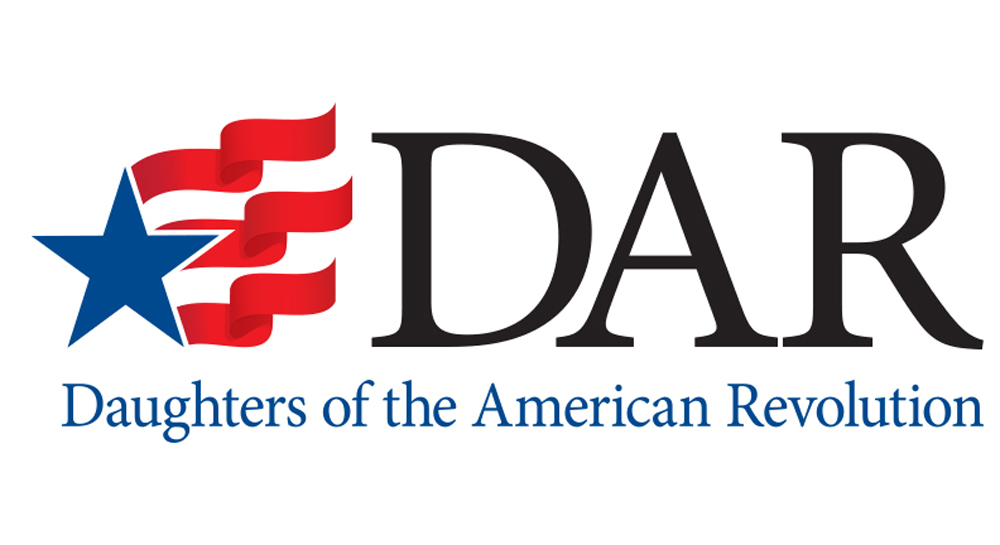Presidio Real de San Agustín del Tucson:
The Four Corners of the Adobe Wall
Historical Significance:
In 1775, the Spanish Presidio Real de San Agustín del Tucson was established by Regular Spanish Army Lieutenant Colonel Hugo O’Conor. The fort was small and poorly constructed. After a large Apache assault in 1782, an eight- to 12-foot high adobe wall was constructed approximately 700 feet long on each side. One of the largest of the frontier presidios, the fort was continually updated until it reached its maximum size of 11 acres. It was used until March 1856.
Walking Tour of the DAR Historical Markers:
Seven historical markers were placed in downtown Tucson during the 1920s and 1930s as members of the Tucson Chapter, NSDAR, were concerned about the preservation of the historic Presidio San Agustín del Tucson. Regent Mabel Moffitt, who served as regent from 1922 to 1926, spearheaded the effort. Each marker is described in this website. The four corners of the surrounding adobe walls are included in this page. The north and south entrances to the enclosure and the central plaza each are described on a separate page.
Provided for your convenience, this handy guide describes a walking tour that visits all seven markers.
Marker:
Northwest Corner of the Adobe Wall,
Presidio Real de San Agustín del Tucson
Location:
Southeast corner of N Main Avenue and W Washington Street. This marker can be found while walking the sidewalk and reaching the corner of Main and Washington. The marker is embedded in the adobe wall (now painted white) that surrounds the yard of the historical J Knox Corbett house, which is part of the Tucson Museum of Art.
Tucson, Pima County, Arizona
32.224377, -110.975808
Historical Significance:
The marker reads, “N. W. Corner Adobe Wall of Spanish Presidio of Tucson / Marked 1926 by D.A.R.”
The marker was dedicated on March 26, 1926, and placed as close to the original site as possible. The marker is a ten-inch bronze plaque embedded in the block wall surrounding the J. Knox Corbett House at the southeast corner of Washington Street and Main Avenue. It is at waist level.
Dedicated:
March 26,1926
Sponsor:
Tucson Chapter, NSDAR
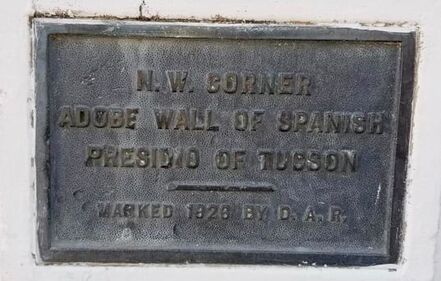
of the adobe wall that surrounded the Presidio.
Undated image.
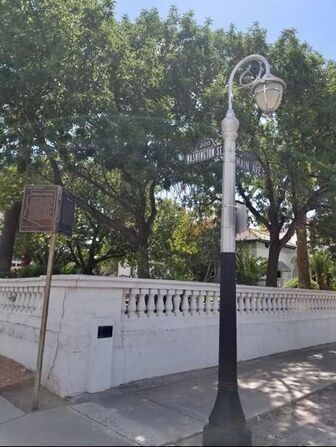
the J. Knox Corbett House.
Undated image.
To continue the walking tour, please return to the guide.
Marker:
Northeast Corner of the Adobe Wall,
Presidio Real de San Agustín del Tucson
Location:
Inside the Presidio San Agustín del Tucson Museum
196 N. Court Avenue
Tucson, Pima County, Arizona
32.224340, -110.973817
Note:
To see this marker you must pay admission and go inside the museum. Visit the museum website for information regarding pricing and hours.
Historical Significance:
The marker reads, “N. E. Corner Adobe Wall of Spanish Presidio of Tucson / Marked 1926 by D.A.R.”
The marker was dedicated on March 26, 1926, and placed as close to the original site as possible. Over the years a parking lot was built close to the marker. Photographs taken in 1976 as part of the U.S. bicentennial celebration show the marker was still in its original location. However, by 1995, the marker had disappeared. Norma Niblett, a member of the El Presidio Chapter, NSDAR, found the cornerstone marker in 2007 in the basement of the Tucson Historical Society, still attached to concrete and metal rods. Apparently, the marker had been struck by a vehicle and was damaged such that it could not be repaired to its original condition.
Fortunately, in 2006 when the parking lot was excavated and the re-creation of the Presidio San Agustín del Tucson was built, the exact corner of the original wall was identified, and the stabilized marker was installed and rededicated. It now identifies the precise location of the northeast corner of the adobe wall of the Presidio. A photograph of the cornerstone marker is published in the book Presidio San Agustin del Tucson: A View of Early Tucson that can be purchased in the gift shop at the museum.
Links:
National Park Service
Dedicated:
March 26,1926
Rededicated:
March 20, 2008
Sponsor:
Tucson Chapter, NSDAR
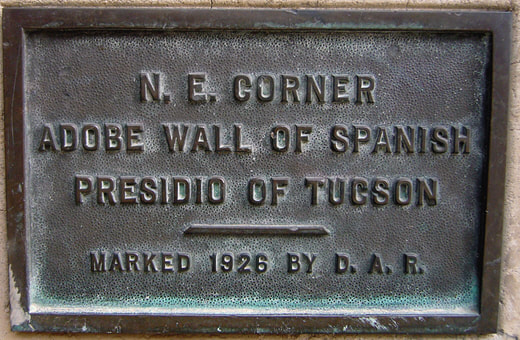
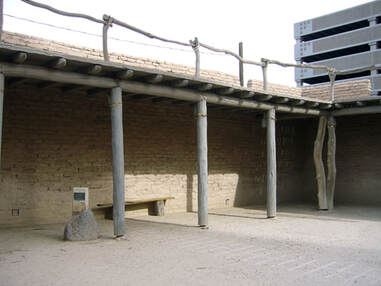

To continue the walking tour, please return to the guide.
Marker:
Southeast Corner of the Adobe Wall,
Presidio Real de San Agustín del Tucson
Location:
Inside the Southern Arizona Heritage and Visitor Center,
in the former Pima County Courthouse
115 N. Church Avenue, Suite 101
Tucson, Pima County, Arizona
32.22349362, -110.9731568002
Historical Significance:
The marker was placed on November 11, 1922, to represent the southeast corner of the Old Adobe Wall of the Presidio. Mabel Moffitt, regent of the Tucson Chapter, NSDAR, from 1922 to 1926, spearheaded the efforts.
The original marker was an engraved stone boulder with the inscription, “This tablet marks the site of the southeast corner of the Old Adobe Wall that protected Tucson from the Indians in the early days prior to 1845.” The stone monument was moved on October 23, 1930, due to construction and was lost.
In 1955, the Tucson Chapter, NSDAR, replaced the marker with a brass quarter-circle disc marking the exact location of the southeast corner, embedding the disc in the floor of the Pima County Assessor’s Office. The disc read, “This disc marks the southeast corner of the old adobe wall that protected Tucson from the Indians in the early days – prior to 1845.” Although this was in a public building, it was difficult for visitors to find.
In the early 2020s, due to a significant construction project, the brass disc was moved to the Southern Arizona Heritage and Visitor Center on the other side of the building. It is displayed alongside a portion of the original adobe wall.
Dedicated:
1922
Rededicated:
1955
Moved:
circa 2022
Sponsor:
Tucson Chapter, NSDAR

This photo was provided to Sandy Lawford, Past Regent, El Presidio Chapter, NSDAR, from Mark Still. His notes from the photo are: “Elizabeth Carter Still unveiling the cornerstone of the southeast corner of an old adobe wall which protected Tucson from the Indians in the early days. Tablet erected by the Tucson Chapter of the D.A.R. Nov. 11, 1922”
“Front row, third from left [taller of the two girls in white] Elizabeth Carter Still [ECS]; behind ECS on the right (the lady with a hat) is her mother Lyde McKeand Still, a charter member of Tucson of DAR and one of it’s [sic] early Regents.”
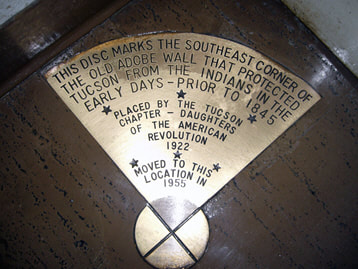

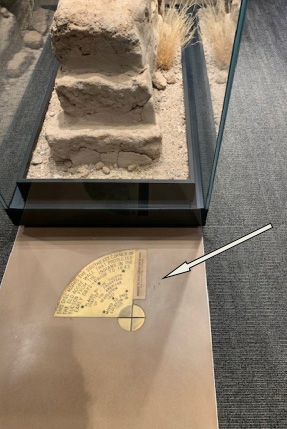
To continue the walking tour, please return to the guide.
Marker:
Southwest Corner of the Adobe Wall,
Presidio Real de San Agustín del Tucson – The marker is missing
Location:
Northwest corner of City Hall Parking Lot
255 W. Alameda Street (in rear of building)
Tucson, Pima County, Arizona
32.222761, -110.974579
Note:
The original marker was replaced by the Tucson Historical Society in 1988 with different wording. The 1988 marker is affixed to remnants of the Old Adobe Wall in front of Tucson city hall next to the parking lot.
Historical Significance:
The original marker read, “S. W. Corner Adobe Wall of Spanish Presidio of Tucson / Marked 1926 by D.A.R.”
The marker was dedicated on March 26, 1926, at the same time as the northeast and northwest cornerstone markers. The three markers were identical bronze plaques less than 10-inches wide.
This marker was placed on the Orndorff Hotel, but it was lost in 1935 when the hotel was destroyed in a fire.
The hotel was built in 1856 and named the Phillips House for its owner. Sam Hughes purchased the hotel from Mr. Phillips, renaming it the Cosmopolitan, and in 1896 sold it to Mrs. A. C. Orndorff. Wood reclaimed from the hotel demolition was used to make a gavel prized by DAR members, the Arizona State Regent Gavel, a gift from the Tucson Chapter, NSDAR.
Dedicated:
March 26,1926
Sponsor:
Tucson Chapter, NSDAR
To complete the walking tour, please return to the guide.
Request Membership Information
The content contained herein does not necessarily represent the position of NSDAR. Hyperlinks to other sites are not the responsibility of the NSDAR, the state organization or individual DAR chapters.
Unless otherwise noted, images are courtesy of Arizona State Society, DAR, Daughters.
